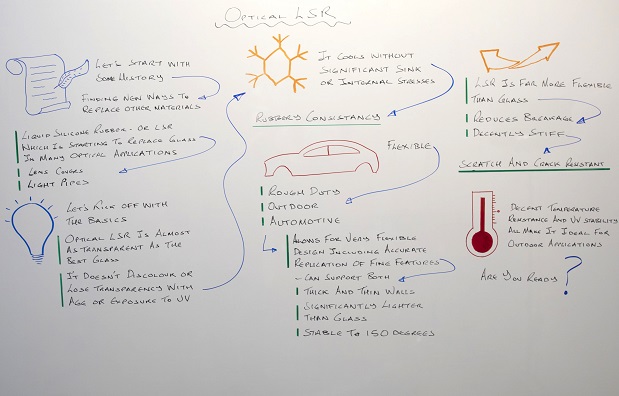
Optical LSR
Your masterclass in product design and development
Protolabs’ Insight video series
Our Insight video series will help you master digital manufacturing.
Every Friday we’ll post a new video – each one giving you a deeper Insight into how to design better parts. We’ll cover specific topics such as choosing the right 3D printing material, optimising your design for CNC machining, surface finishes for moulded parts, and much more besides.
So join us and don’t miss out.
Insight: Optical LSR
Transcript
Hi, it’s Friday, which means it’s time for another Insight video.
This week I’m going to light up your world with optical liquid silicone rubber – wow.
But let’s start with some history. When taken as a whole, the history of plastic revolves around finding new ways to replace other materials. Back in the 19th century this started with cutting out ivory and tortoiseshell and as our technology has got better and better, we’ve been able to switch even more materials to cheap and tough, reliable plastics.

One of the latest examples of this lies in liquid silicone rubber – or LSR – which is starting to replace glass in many optical applications, including lens covers and light pipes.
In many ways, this is a revelation. Glass has seemed like the ideal shell for lightbulbs ever since they were being designed by Edison, and for a very good reason. It is almost perfectly transparent, inexpensive, has a defined manufacturing process, and is more or less impervious to the considerable heat generated by incandescent light elements.
However, this waste heat – and therefore waste electricity – is the very reason why those incandescent bulbs are dying off. LEDs are a bit more expensive to produce at the moment, but they more than make up for their initial cost with energy efficiency and long life.
And while glass could be used to enclose, cover, or direct them, optical LSR is a better choice in almost every way. But why is this?
Well, let’s kick off with the basics.

Optical LSR is almost as transparent as the best glass, it doesn’t discolour or lose transparency with age or exposure to UV, and it’s significantly lighter than glass. It’s optically and mechanically stable at up to 150 degrees, which is more than enough to cope with any heat put out by LEDs.
As you can probably guess, all of these are huge benefits.

On top of that, LSR is far more flexible than glass, which reduces the chance of breakage, but is still decently stiff. This stiffness is particularly valuable in applications like vehicle lenses where lights can be exposed to a variety of vibrations and blows.
It’s also nicely scratch and crack-resistant, which helps preserve both its physical integrity and optical properties. Don’t get me wrong, you could cut a part made of optical LSR if you went at it with a razor, but if you were to drag it across the ground or other rough surface it would probably conform to the surface as it was dragged and come out the other side in pretty much the same state that it started

By the way, this flexibility, it’s decent temperature resistance and UV stability all make it ideal for outdoor applications.
That’s a lot of good reasons why optical LSR is a good material for your finished design. Let’s take a quick breather while we can, though, because next up I’m going to run through the reasons why it’s also good to work with from a design perspective.
Are you ready?
Right, first of all, LSR moulding is an optimised process that uses less manufacturing space and energy than a glass manufacturing facility, which allows for prototype and low-volume production runs.
Its low viscosity allows easy flow within a mould, which gives the designer much greater freedom when creating fine features. With LSR you can get away with much thinner walls than could normally be produced in other resins.

Next, it cools without creating significant sink or internal stresses. This dimensional stability allows accurate production of lenses, which is rather important in optical applications.
The material can also be moulded within a polished mould without the use of secondary polishing processes saving time and money in production.

The somewhat rubbery consistency of LSR means that shapes with small undercuts and negative draft that would be unacceptable in a more rigid material may be able to be safely unmoulded and treated as bump-offs or pickouts.
Finally, its flexibility allows you to combine a lens with a seal to reduce assembly cost and inventory control, and to cut out the need for seams in the assembly.
Okay, that was a lot of information.
To recap, optical LSR is a thermosetting material that is absolutely ideal for many optical applications. In terms of clarity it’s second only to glass, it can withstand heat in proximity to high-output LEDs and work just fine in a range of ambient temperatures.

It’s flexible enough for rough duty, outdoor, and automotive use, allows for very flexible design including accurate replication of fine features and can support both thick and thin walls.
You know, I think that’s probably about enough for today. But we’ll be back next week with another video, so be sure to check back in then.
With special thanks to Natalie Constable









